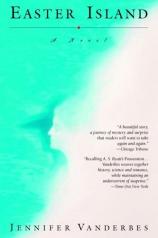Easter Island
Review
Easter Island
Many reviewers and readers have commented on Jennifer Vanderbes's use of remote Easter Island and its geography in her debut novel, yet few have remarked on her use of the island's name for her title. A thorough read of this always complex and sometimes dissatisfying book reveals that Vanderbes chose that title carefully.
Easter Island, an isosceles triangle of volcanic rock in the Pacific Ocean, is two thousand miles from both Tahiti and Chile and one of the most isolated places on earth. Known today as "Rapa Nui," or "Great Rapa" (to distinguish it from "Little Rapa," or "Rapa Iti"), the island's earliest native settlers called it "Te Piti O Te Henua," or "the navel of the world." In 1722, Admiral Roggeveen stumbled across the island on Easter Sunday, and bestowed its most familiar moniker upon it. The contrast of great to small, the symbolism of the navel, and the connotations of the Christian Easter --- none of this is lost on Vanderbes, who has crafted a story involving sibling and spousal rivalry, connectedness and separation, frustration and hope.
The two women involved are the English Elsa Pendleton who, in 1912, makes a marriage of convenience to anthropologist Edward Beazley, and Greer Sandor who, in the 1960s, makes a marriage of inconvenience to her botany professor, Thomas Farraday. We encounter Elsa as she, her mentally challenged younger sister Alice, and Edward undertake the physically arduous journey from London via Boston to Easter Island; we meet Greer as she leaves Boston for Easter Island in 1973, after the deaths of both her marriage and Thomas.
The parallels between these women's lives --- particularly the stunning and painful betrayals both suffer --- would be rich enough material for nearly any novelist. What makes EASTER ISLAND remarkable are the other universal mysteries Vanderbes stitches in: the putative answer to why the island's enormous stone statues (the moai) exist, the reason for WWI German Admiral von Spee's disastrous Falklands encounter with the British, and the answer to the riddle of the world's oldest angiosperm, or flower.
These mysteries, the novel's great strength, are also part of its weakness: the link between von Spee and Elsa does not ring true, and it is in these sections where Vanderbes's voice falters the most. Yet the alternating layers of narrative do offer well-paced suspense. Surprisingly, the suspense is greater in the sections on Greer Farraday's doctoral struggles, and her '70s feminist dilemma sheds light on Elsa's pre-feminist lot. The fact that Vanderbes can convincingly portray a young Edwardian governess, a thirty-something modern palynologist, and still offer a realistic and sympathetic devout middle-aged Polynesian woman (proprietor of Greer's Easter Island residencial), bodes well for her future work.
While Greer labors over her core samples, searching for pollen clues, we learn about Elsa's discovery of her talent for anthropology and linguistics as she deciphers the rongorongo hieroglyphics found on the island. Both women ride waves of loss and loneliness tempered by unusual companions: for Elsa, young islander "Biscuit Tin," and for Greer, fellow scientist Vicente Portales. Vanderbes resists the temptation to make the women's lives identical; the lines she draws between them are more subtle and perhaps, as she suggests, more beautiful in their asymmetry.
Reviewed by Bethanne Kelly Patrick on January 21, 2011
Easter Island
- Publication Date: June 1, 2004
- Genres: Fiction
- Paperback: 320 pages
- Publisher: Dial Press Trade Paperback
- ISBN-10: 0385336748
- ISBN-13: 9780385336741










